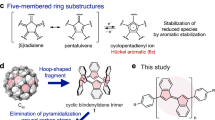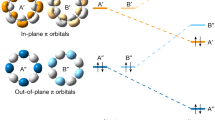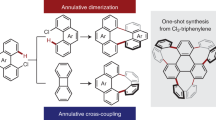Abstract
Warped carbon-rich molecules have captured the imagination of scientists across many disciplines. Owing to their promising materials properties and challenging synthesis, strained hydrocarbons are attractive targets that push the limits of synthetic methods and molecular design. Herein we report the synthesis and characterization of [5]cycloparaphenylene ([5]CPP), a carbon nanohoop that can be envisaged as an open tubular fragment of C60, the equator of C70 fullerene and the unit cycle of a [5,5] armchair carbon nanotube. Given its calculated 119 kcal mol−1 strain energy and severely distorted benzene rings, this synthesis, which employs a room-temperature macrocyclization of a diboronate precursor, single-electron reduction and elimination, is remarkably mild and high yielding (27% over three steps). Single-crystal X-ray diffraction data were obtained to confirm its geometry and previously disputed benzenoid character. First and second pseudoreversible oxidation and reduction events were observed via cyclic voltammetry. The ease of synthesis, high solubility and narrowest optical HOMO/LUMO gap of any para-polyphenylene synthesized make [5]CPP a desirable new material for organic electronics.
This is a preview of subscription content, access via your institution
Access options
Subscribe to this journal
Receive 12 print issues and online access
$259.00 per year
only $21.58 per issue
Buy this article
- Purchase on Springer Link
- Instant access to full article PDF
Prices may be subject to local taxes which are calculated during checkout





Similar content being viewed by others
References
Eaton, P. E. & Cole, T. W. Cubane. J. Am. Chem. Soc. 86, 3157–3158 (1964).
Lawton, R. G. & Barth, W. E. Synthesis of corannulene. J. Am. Chem. Soc. 93, 1730–1745 (1971).
Dauben, W. G. & Cargill, R. L. Photochemical transformations, VIII: the isomerization of Δ2,5-bicyclo[2.2.1]heptadiene to quadricyclo[2.2.1.02,6-03,5]heptane (quadricyclene). Tetrahedron 15, 197–201 (1961).
Kammermeier, S., Jones, P. G. & Herges, R. Ring-expanding metathesis of tetradehydro-anthracene—synthesis and structure of a tubelike, fully conjugated hydrocarbon. Angew. Chem. Int. Ed. Engl. 35, 2669–2671 (1996).
Kane, V. V., Wolf, A. D. & Jones, M. [6]Paracyclophane. J. Am. Chem. Soc. 96, 2643–2644 (1974).
Scott, L. T. et al. A rational chemical synthesis of C60 . Science 295, 1500–1503 (2002).
Hopf, H. Classics in Hydrocarbon Chemistry (Wiley-VCH, 2000).
Scott, L. T. Conjugated belts and nanorings with radially oriented p orbitals. Angew. Chem. Int. Ed. 42, 4133–4135 (2003).
Parekh, V. C. & Guha, P. C. Synthesis of p,p-diphenylene disulfide. J. Indian Chem. Soc. 11, 95–100 (1934).
Yamago, S., Watanabe, Y. & Iwamoto, T. Synthesis of [8]cycloparaphenylene from a square-shaped tetranuclear platinum complex. Angew. Chem. Int. Ed. 49, 757–759 (2010).
Omachi, H., Matsuura, S., Segawa, Y. & Itami, K. A modular and size-selective synthesis of [n]cycloparaphenylenes: a step toward the selective synthesis of [n,n] single-walled carbon nanotubes. Angew. Chem. Int. Ed. 49, 10202–10205 (2010).
Jasti, R., Bhattacharjee, J., Neaton, J. B. & Bertozzi, C. R. Synthesis, characterization, and theory of [9]-, [12]-, and [18]cycloparaphenylene: carbon nanohoop structures. J. Am. Chem. Soc. 130, 17646–17647 (2008).
Srinivasan, M., Sankararaman, S., Hopf, H. & Varghese, B. Synthesis of buta-1,3-diyne-bridged macrocycles with (Z)-1,4-diethynyl-1,4-dimethoxycyclohexa-2,5-diene as the building block. Eur. J. Org. Chem. 2003, 660–665 (2003).
Xia, J. & Jasti, R. Synthesis, characterization, and crystal structure of [6]cycloparaphenylene. Angew. Chem. Int. Ed. 51, 2474–2476 (2012).
Golder, M. R., Wong, B. M. & Jasti, R. Photophysical and theoretical investigations of the [8]cycloparaphenylene radical cation and its charge-resonance dimer. Chem. Sci. 4, 4285–4291 (2013).
Zabula, A. V., Filatov, A. S., Xia, J., Jasti, R. & Petrukhina, M. A. Tightening of the nanobelt upon multielectron reduction. Angew. Chem. Int. Ed. 52, 5033–5036 (2013).
Iwamoto, T., Watanabe, Y., Sadahiro, T., Haino, T. & Yamago, S. Size-selective encapsulation of C60 by [10]cycloparaphenylene: formation of the shortest fullerene-peapod. Angew. Chem. Int. Ed. 50, 8342–8344 (2011).
Xia, J., Bacon, J. W. & Jasti, R. Gram-scale synthesis and crystal structures of [8]- and [10]CPP, and the solid-state structure of C60@[10]CPP. Chem. Sci. 3, 3018–3021 (2012).
Hirst, E. S. & Jasti, R. Bending benzene: syntheses of [n]cycloparaphenylenes. J. Org. Chem. 77, 10473–10478 (2012).
Omachi, H., Nakayama, T., Takahashi, E., Segawa, Y. & Itami, K. Initiation of carbon nanotube growth by well-defined carbon nanorings. Nature Chem. 5, 572–576 (2013).
Darzi, E. R., Sisto, T. J. & Jasti, R. Selective syntheses of [7]–[12]cycloparaphenylenes using orthogonal Suzuki–Miyaura cross-coupling reactions. J. Org. Chem. 77, 6624–6628 (2012).
Iwamoto, T., Watanabe, Y., Sakamoto, Y., Suzuki, T. & Yamago, S. Selective and random syntheses of [n]cycloparaphenylenes (n=8–13) and size dependence of their electronic properties. J. Am. Chem. Soc. 133, 8354–8361 (2011).
Sisto, T. J., Golder, M. R., Hirst, E. S. & Jasti, R. Selective synthesis of strained [7]cycloparaphenylene: an orange-emitting fluorophore. J. Am. Chem. Soc. 133, 15800–15802 (2011).
Kayahara, E., Iwamoto, T., Suzuki, T. & Yamago, S. Selective synthesis of [6]-, [8]-, and [10]cycloparaphenylenes. Chem. Lett. 42, 621–623 (2013).
Kayahara, E., Sakamoto, Y., Suzuki, T. & Yamago, S. Selective synthesis and crystal structure of [10]cycloparaphenylene. Org. Lett. 14, 3284–3287 (2012).
Sibbel, F., Matsui, K., Segawa, Y., Studer, A. & Itami, K. Selective synthesis of [7]- and [8]cycloparaphenylenes. Chem. Commun. 50, 954–956 (2013).
Segawa, Y. et al. [9]Cycloparaphenylene: nickel-mediated synthesis and crystal structure. Chem. Lett. 40, 423–425 (2011).
Segawa, Y. et al. Concise synthesis and crystal structure of [12]cycloparaphenylene. Angew. Chem. Int. Ed. 50, 3244–3248 (2011).
Ishii, Y. et al. Size-selective synthesis of [9]–[11] and [13]cycloparaphenylenes. Chem. Sci. 3, 2340–2345 (2012).
Hitosugi, S., Nakanishi, W., Yamasaki, T. & Isobe, H. Bottom-up synthesis of finite models of helical (n,m)-single-wall carbon nanotubes. Nature Commun. 2, 492 (2011).
Yagi, A., Segawa, Y. & Itami, K. Synthesis and properties of [9]cyclo-1,4-naphthylene: a π-extended carbon nanoring. J. Am. Chem. Soc. 134, 2962–2965 (2012).
Matsui, K., Segawa, Y. & Itami, K. Synthesis and properties of cycloparaphenylene-2,5-pyridylidene: a nitrogen-containing carbon nanoring. Org. Lett. 14, 1888–1891 (2012).
Sisto, T. J., Tian, X. & Jasti, R. Synthesis of tetraphenyl-substituted [12]cycloparaphenylene: toward a rationally designed ultrashort carbon nanotube. J. Org. Chem. 77, 5857–5860 (2012).
Wong, B. M. Optoelectronic properties of carbon nanorings: excitonic effects from time-dependent density functional theory. J. Phys. Chem. C 113, 21921–21927 (2009).
Frisch, M. J. et al. Gaussian 09, Revision D.01 (Gaussian Inc., 2009).
Nakamura, E., Tahara, K., Matsuo, Y. & Sawamura, M. Synthesis, structure, and aromaticity of a hoop-shaped cyclic benzenoid [10]cyclophenacene. J. Am. Chem. Soc. 125, 2834–2835 (2003).
Anslyn, E. & Dougherty, D. Modern Physical Organic Chemistry 183–185 (University Science Books, 2008).
Punna, S., Díaz, D. D. & Finn, M. G. Palladium-catalyzed homocoupling of arylboronic acids and esters using fluoride in aqueous solvents. Synlett 2004, 2351–2354 (2004).
Moreno-Mañas, M., Pérez, M. & Pleixats, R. Palladium-catalyzed Suzuki-type self-coupling of arylboronic acids. A mechanistic study. J. Org. Chem. 61, 2346–2351 (1996).
Tobe, Y., Jimbo, M., Saiki, S., Kakiuchi, K. & Naemura, K. Unusual reactivity of [6]paracyclophane toward alkyllithiums. J. Org. Chem. 58, 5883–5885 (1993).
Tobe, Y. et al. Synthesis and molecular structure of (Z)-[6]paracycloph-3-enes. J. Am. Chem. Soc. 109, 1136–1144 (1987).
Jagadeesh, M. N., Makur, A. & Chandrasekhar, J. The interplay of angle strain and aromaticity: molecular and electronic structures of [0n]paracyclophanes. J. Mol. Model. 6, 226–233 (2000).
Allinger, N. L., Walter, T. J. & Newton, M. G. Synthesis, structure, and properties of the [7]paracyclophane ring system. J. Am. Chem. Soc. 96, 4588–4597 (1974).
Tobe, Y. et al. Synthesis, structure and reactivities of [6]paracyclophanes. Tetrahedron 42, 1851–1858 (1986).
Baran, P. S. & Burns, N. Z. Total synthesis of (±)-haouamine A. J. Am. Chem. Soc. 128, 3908–3909 (2006).
Takiguchi, H., Ohmori, K. & Suzuki, K. Synthesis and determination of the absolute configuration of cavicularin by a symmetrization/asymmetrization approach. Angew. Chem. Int. Ed. 52, 10472–10476 (2013).
Nikolaev, A. V., Dennis, T. J. S., Prassides, K. & Soper, A. K. Molecular structure of the C70 fullerene. Chem. Phys. Lett. 223, 143–148 (1994).
Scott, L. T. et al. A short, rigid, structurally pure carbon nanotube by stepwise chemical synthesis. J. Am. Chem. Soc. 134, 107–110 (2011).
Fujitsuka, M., Cho, D. W., Iwamoto, T., Yamago, S. & Majima, T. Size-dependent fluorescence properties of [n]cycloparaphenylenes (n=8–13), hoop-shaped π-conjugated molecules. Phys. Chem. Chem. Phys. 14, 14585–14588 (2012).
Kawasumi, K., Zhang, Q., Segawa, Y., Scott, L. T. & Itami, K. A grossly warped nanographene and the consequences of multiple odd-membered-ring defects. Nature Chem. 5, 739–744 (2013).
Acknowledgements
This work was supported by a National Science Foundation CAREER award (CHE-1255219), an Alfred P. Sloan Research Fellowship and a Boston University Ignition Award. The authors gratefully acknowledge J. Bacon (Boston University) for crystal-structure determination.
Author information
Authors and Affiliations
Contributions
E.R.D. and P.J.E. conceived the project, designed and carried out the experiments, performed the calculations, analysed the data and wrote the manuscript with equal contribution. As such, E.R.D. and P.J.E. are credited as co-first authors. R.J. played a critical role in discussion of the experimental design, project direction, experiments and results, and preparation of the manuscript.
Corresponding author
Ethics declarations
Competing interests
The authors declare no competing financial interests.
Supplementary information
Supplementary information
Supplementary information (PDF 1955 kb)
Supplementary information
Crystallographic data for compound 3 (CIF 1175 kb)
Supplementary information
Crystallographic data for compound [5]CPP (CIF 132 kb)
Rights and permissions
About this article
Cite this article
Evans, P., Darzi, E. & Jasti, R. Efficient room-temperature synthesis of a highly strained carbon nanohoop fragment of buckminsterfullerene. Nature Chem 6, 404–408 (2014). https://doi.org/10.1038/nchem.1888
Received:
Accepted:
Published:
Issue Date:
DOI: https://doi.org/10.1038/nchem.1888
This article is cited by
-
Three-dimensional conjugated macrocycle with large polyaromatic blocks constructed by post-π-extension
Science China Chemistry (2020)
-
Emerging applications of carbon nanohoops
Nature Reviews Chemistry (2019)
-
Hollow organic capsules assemble into cellular semiconductors
Nature Communications (2018)
-
Describing excited states of [n]cycloparaphenylenes by hybrid and double-hybrid density functionals: from isolated to weakly interacting molecules
Theoretical Chemistry Accounts (2016)
-
Closing the loop
Nature Chemistry (2014)



